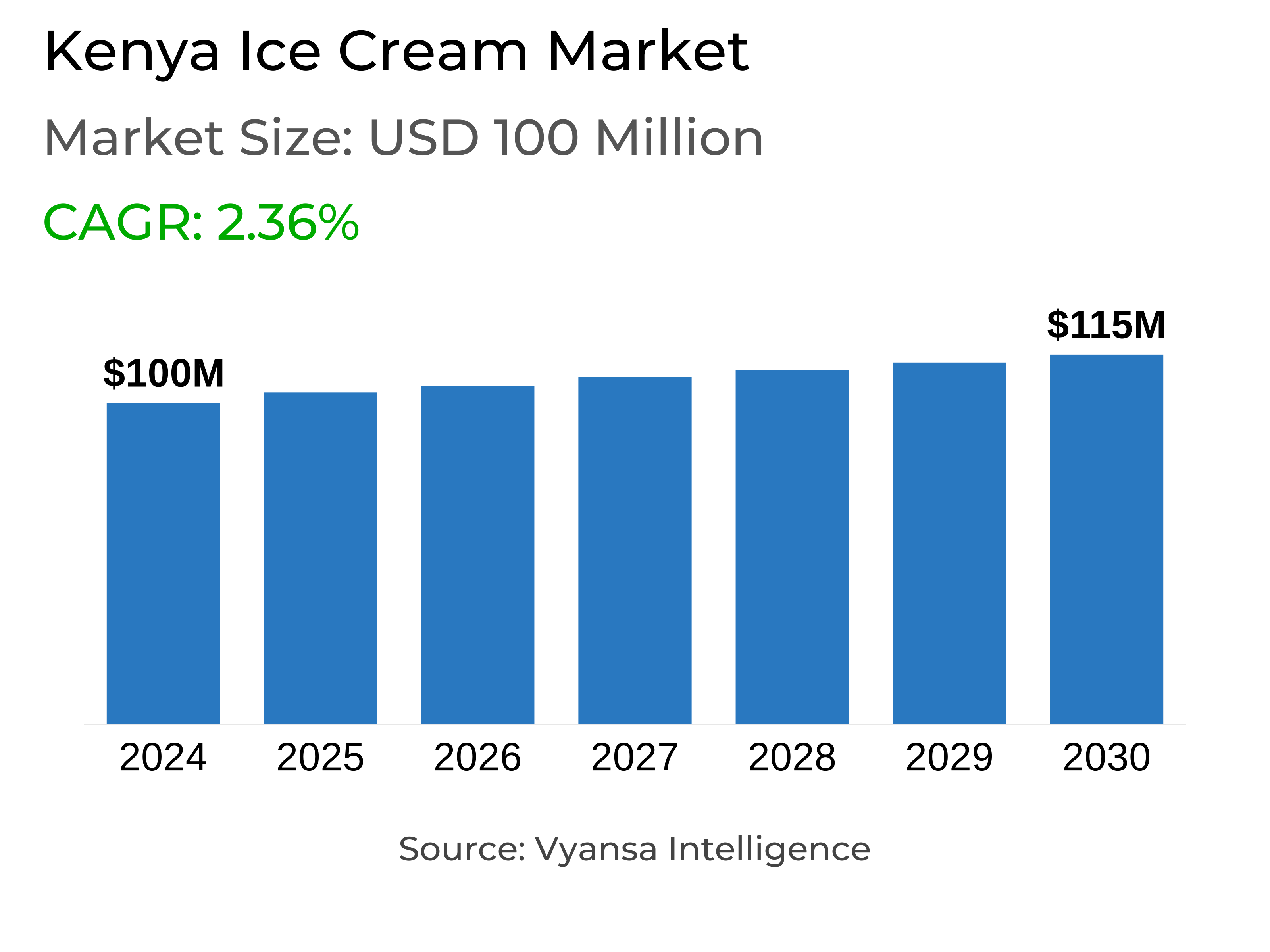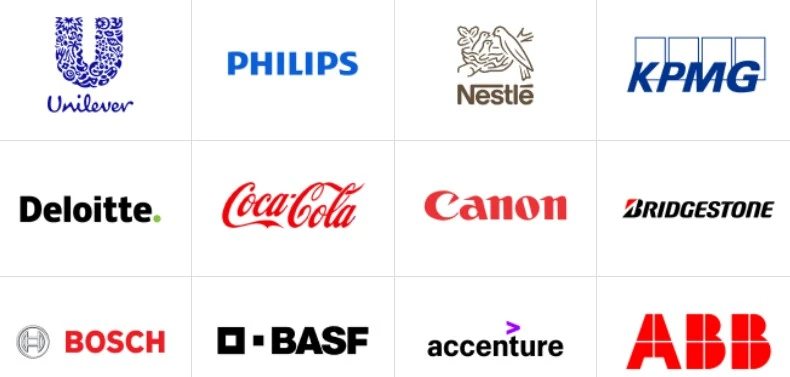Kenya Ice Cream Market Report: Trends, Growth and Forecast (2025-2030)
By Category (Frozen Yoghurt, Impulse Ice Cream, Plant-based Ice Cream, Take-Home Ice Cream), By Leading Flavours (Chocolate, Vanilla, Strawberry, Cookies & Cream, Caramel, Mango, Pralines & Cream, Kulfi), By Format (Cup, Stick, Cone, Brick), By Sales Channel (Retail Offline, Retail E-Commerce)
- Food & Beverage
- Dec 2025
- VI0003
- 118
-




Kenya Ice Cream Market Statistics and Insights, 2025
- Market Size Statistics
- Ice Cream in Kenya is estimated at $ 100 Million.
- The market size is expected to grow to $ 115 Million by 2030.
- Market to register a CAGR of around 2.36% during 2025-30.
- Product Shares Shares
- Impulse Ice Cream grabbed market share of 60%.
- Impulse Ice Cream to witness a volume CAGR of around 0.39%.
- Competition
- More than 10 companies are actively engaged in producing Ice Cream in Kenya.
- Top 5 companies acquired 80% of the market share.
- Sameer Agriculture & Livestock Ltd, Unipex Dairy Products Co Ltd, Bakhresa Food Products Ltd, Glacier Products Ltd, Mars Inc etc., are few of the top companies.
- Sales Channel
- Retail Offline grabbed 95% of the market.
Kenya Ice Cream Market Outlook
Kenya ice cream market is ready for stable growth in 2025, amid escalating inflation and production costs that have made consumers more price-sensitive. This change in consumption behaviour is encouraging consumers to opt for smaller pack sizes and affordable products, which is leading manufacturers to adjust with promotional pricing and offers. For example, Alpha Dairy Products has used "buy one get one free" offers to maintain price affordability and consumer loyalty.
Single-serve ice cream and impulse dairy segments are leading the growth, supported by their convenience and fit with fast-paced urban lifestyles of most Kenyans. However, single-serve water ice cream is experiencing a drop in formal retail channels, partially due to health issues and scarce supply, while it remains strong in the informal market via local vendors.
Dairyland continues to lead the market as an innovator, introducing Kenya's first soy-based, vegan ice cream. The product addresses Kenya's increasing population of lactose-intolerant consumers and aligns with global trends in wellness, further solidifying Dairyland's position as a leader based on quality products and ongoing innovations.
Supermarket private label brands such as Carrefour and Naivas are becoming potent rivals by providing cheaper alternatives, compelling existing players to steer their product and pricing strategies. In the meantime, growing disposable incomes and rising demand for premium experiences are driving market growth in bulk and take-home dairy ice cream, as well as new distribution formats such as the "London Ice Cream Truck." Going forward, indulgence, innovation, and affordability will be the primary pillars of growth in the market, whereas the single-serve water ice cream category can expect rising challenges from changing consumer attitudes.

Kenya Ice Cream Market Growth Driver
The Increasing Disposable income and ongoing improving lifestyle in Kenya. It is being driven by the increased purchasing power and indulgent product seeking, the ice cream demand is rising. It compelled the companies to innovate in the market at local levels, efforts made by companies like 'London Ice Cream Truck'. The idea provides convenience and novelty to the end users by introducing the ice cream at the door step or on-the-go idea, avoiding the trip to the stores. Such innovative models are filling gaps between the manufacturers and the end users. Additionally, the ongoing lifestyle improvements have boosted the purchasing power of the end users, not just booing consumption of the ice creams but compelled the companies to innovate more advanced delivery and interaction mechanisms.
Kenya Ice Cream Market Challenge
Increasing inflation and rising cost of production is making the end users price conscious in 2025. The economic squeeze is driving the end users perception towards lower priced alternatives and smaller pack sizes. Hence, it made it challenging for the manufacturers to hold on to the market share.
Further, in order to tackle the scenario, the businesses have been launching campaigns, tweaking the pricing strategies. For example, Alpha Dairy Products under the brand name "Ooh!" have launched promotional campaigns like "buy one get one free" to target the price sensitive end users. It makes the manufacturers under duress reduce the price of the products and provide the offers, thus cutting the profit margins.
Kenya Ice Cream Market Trend
The end consumers are becoming increasingly health conscious. It is generating an increase in demand towards health and wellness trends. The players, realizing the trend, are innovating the ice creams accordingly the ice cream. For example, Dairyland introduced the world's first Dairy free vegan ice cream, the soy based alternative particularly meets the lactose intolerant end users that are on rise who desire indulgent dessert while at the same time must be fit for catering such end users.
The launch of vegan flavours like vanilla, strawberry, hazelnut etc., reflects a wider end user population. The launch reflects the increasing popularity of plant based alternatives and continuous innovations which is the major trend driving dynamically growing the ice cream market of Kenya.
| Report Coverage | Details |
|---|---|
| Market Forecast | 2025-30 |
| USD Value 2024 | $ 100 Million |
| USD Value 2030 | $ 115 Million |
| CAGR 2025-2030 | 2.36% |
| Largest Category | Impulse Ice Cream segment leads with 60% market share |
| Top Drivers | Rising Disposable Income and Lifestyle Improvements Fueling Demand and Innovation |
| Top Challenges | Inflation and Cost Pressures Leading to Price Sensitivity and Margin Squeeze |
| Top Trends | Growing Demand for Plant-Based and Health-Conscious Ice Cream Alternatives |
| Key Players | Sameer Agriculture & Livestock Ltd, Unipex Dairy Products Co Ltd, Bakhresa Food Products Ltd, Glacier Products Ltd, Mars Inc, Razco Ltd, Froneri South Africa (Pty) Ltd, Crystal Ice Cream Ltd, Alpha Dairy Products Ltd, Del Monte Kenya Ltd and Others. |
Kenya Ice Cream Market Segmentation Analysis

Demand in Impulse Ice Cream segment is being fueled by growing popularity of impulse dairy single-serve ice creams. The ice cream category fits the fast moving, on-the-move lifestyle which is typically adopted by majority of end users of Kenya. It gives a convenient, pleasurable treat while on the move. It is extensively available in formal retail channels which enhances the segment growth.
Top Companies in Kenya Ice Cream Market
The top companies operating in the market include Sameer Agriculture & Livestock Ltd, Unipex Dairy Products Co Ltd, Bakhresa Food Products Ltd, Glacier Products Ltd, Mars Inc, Razco Ltd, Froneri South Africa (Pty) Ltd, Crystal Ice Cream Ltd, Alpha Dairy Products Ltd, Del Monte Kenya Ltd, etc., are the top players operating in the Kenya Ice Cream Market.
Frequently Asked Questions
Related Report
1. Market Segmentation
1.1. Research Scope
1.2. Research Methodology
1.3. Definitions and Assumptions
2. Executive Summary
3. Kenya Ice Cream Market Policies, Regulations, and Standards
4. Kenya Ice Cream Market Dynamics
4.1. Growth Factors
4.2. Challenges
4.3. Trends
4.4. Opportunities
5. Kenya Ice Cream Market Statistics, 2020-2030F
5.1. Market Size & Growth Outlook
5.1.1.By Revenues in US$ Million
5.1.2.By Volume in Million Litres
5.2. Market Segmentation & Growth Outlook
5.2.1.By Category
5.2.1.1. Frozen Yoghurt- Market Insights and Forecast, 2020-2030, USD Million
5.2.1.2. Impulse Ice Cream- Market Insights and Forecast, 2020-2030, USD Million
5.2.1.2.1. Single Portion Dairy Ice Cream- Market Insights and Forecast, 2020-2030, USD Million
5.2.1.2.2. Single Portion Water Ice Cream- Market Insights and Forecast, 2020-2030, USD Million
5.2.1.3. Plant-based Ice Cream- Market Insights and Forecast, 2020-2030, USD Million
5.2.1.4. Take-Home Ice Cream- Market Insights and Forecast, 2020-2030, USD Million
5.2.1.4.1. Take-Home Dairy Ice Cream- Market Insights and Forecast, 2020-2030, USD Million
5.2.1.4.1.1. Bulk Dairy Ice Cream- Market Insights and Forecast, 2020-2030, USD Million
5.2.1.4.1.2. Multi-Pack Dairy Ice Cream- Market Insights and Forecast, 2020-2030, USD Million
5.2.1.4.2. Take-Home Water Ice Cream- Market Insights and Forecast, 2020-2030, USD Million
5.2.1.4.2.1. Bulk Water Ice Cream- Market Insights and Forecast, 2020-2030, USD Million
5.2.1.4.2.2. Multi-Pack Water Ice Cream- Market Insights and Forecast, 2020-2030, USD Million
5.2.2.By Leading Flavours
5.2.2.1. Chocolate- Market Insights and Forecast, 2020-2030, USD Million
5.2.2.2. Vanilla- Market Insights and Forecast, 2020-2030, USD Million
5.2.2.3. Strawberry- Market Insights and Forecast, 2020-2030, USD Million
5.2.2.4. Cookies & Cream- Market Insights and Forecast, 2020-2030, USD Million
5.2.2.5. Caramel- Market Insights and Forecast, 2020-2030, USD Million
5.2.2.6. Mango- Market Insights and Forecast, 2020-2030, USD Million
5.2.2.7. Pralines & Cream- Market Insights and Forecast, 2020-2030, USD Million
5.2.2.8. Kulfi- Market Insights and Forecast, 2020-2030, USD Million
5.2.3.By Format
5.2.3.1. Cup- Market Insights and Forecast, 2020-2030, USD Million
5.2.3.2. Stick- Market Insights and Forecast, 2020-2030, USD Million
5.2.3.3. Cone- Market Insights and Forecast, 2020-2030, USD Million
5.2.3.4. Brick- Market Insights and Forecast, 2020-2030, USD Million
5.2.3.5. Others (Sandwich, Tub, etc.)- Market Insights and Forecast, 2020-2030, USD Million
5.2.4.By Sales Channel
5.2.4.1. Retail Offline- Market Insights and Forecast, 2020-2030, USD Million
5.2.4.1.1. Grocery Retailers- Market Insights and Forecast, 2020-2030, USD Million
5.2.4.1.1.1. Convenience Retailers- Market Insights and Forecast, 2020-2030, USD Million
5.2.4.1.1.1.1. Convenience Stores- Market Insights and Forecast, 2020-2030, USD Million
5.2.4.1.1.1.2. Forecourt Retailers- Market Insights and Forecast, 2020-2030, USD Million
5.2.4.1.1.2. Supermarkets- Market Insights and Forecast, 2020-2030, USD Million
5.2.4.1.1.3. Hypermarkets- Market Insights and Forecast, 2020-2030, USD Million
5.2.4.1.1.4. Food & Drink Specialists- Market Insights and Forecast, 2020-2030, USD Million
5.2.4.1.1.5. Small Local Grocers- Market Insights and Forecast, 2020-2030, USD Million
5.2.4.2. Retail E-Commerce- Market Insights and Forecast, 2020-2030, USD Million
5.2.5.By Competitors
5.2.5.1. Competition Characteristics
5.2.5.2. Market Share & Analysis
6. Kenya Frozen Yoghurt Ice Cream Market Statistics, 2020-2030F
6.1. Market Size & Growth Outlook
6.1.1.By Revenues in US$ Million
6.1.2.By Volume in Million Litres
6.2. Market Segmentation & Growth Outlook
6.2.1.By Leading Flavours- Market Insights and Forecast, 2020-2030, USD Million
6.2.2.By Format- Market Insights and Forecast, 2020-2030, USD Million
6.2.3.By Sales Channel- Market Insights and Forecast, 2020-2030, USD Million
7. Kenya Impulse Ice Cream Market Statistics, 2020-2030F
7.1. Market Size & Growth Outlook
7.1.1.By Revenues in US$ Million
7.1.2.By Volume in Million Litres
7.2. Market Segmentation & Growth Outlook
7.2.1.By Leading Flavours- Market Insights and Forecast, 2020-2030, USD Million
7.2.2.By Format- Market Insights and Forecast, 2020-2030, USD Million
7.2.3.By Sales Channel- Market Insights and Forecast, 2020-2030, USD Million
8. Kenya Plant-based Ice Cream Market Statistics, 2020-2030F
8.1. Market Size & Growth Outlook
8.1.1.By Revenues in US$ Million
8.1.2.By Volume in Million Litres
8.2. Market Segmentation & Growth Outlook
8.2.1.By Leading Flavours- Market Insights and Forecast, 2020-2030, USD Million
8.2.2.By Format- Market Insights and Forecast, 2020-2030, USD Million
8.2.3.By Sales Channel- Market Insights and Forecast, 2020-2030, USD Million
9. Kenya Take-Home Ice Cream Market Statistics, 2020-2030F
9.1. Market Size & Growth Outlook
9.1.1.By Revenues in US$ Million
9.1.2.By Volume in Million Litres
9.2. Market Segmentation & Growth Outlook
9.2.1.By Leading Flavours- Market Insights and Forecast, 2020-2030, USD Million
9.2.2.By Format- Market Insights and Forecast, 2020-2030, USD Million
9.2.3.By Sales Channel- Market Insights and Forecast, 2020-2030, USD Million
10. Competitive Outlook
10.1. Company Profiles
10.1.1. Sameer Agriculture & Livestock Ltd
10.1.1.1. Business Description
10.1.1.2. Product Portfolio
10.1.1.3. Collaborations & Alliances
10.1.1.4. Recent Developments
10.1.1.5. Financial Details
10.1.1.6. Others
10.1.2. Unipex Dairy Products Co Ltd
10.1.2.1. Business Description
10.1.2.2. Product Portfolio
10.1.2.3. Collaborations & Alliances
10.1.2.4. Recent Developments
10.1.2.5. Financial Details
10.1.2.6. Others
10.1.3. Bakhresa Food Products Ltd
10.1.3.1. Business Description
10.1.3.2. Product Portfolio
10.1.3.3. Collaborations & Alliances
10.1.3.4. Recent Developments
10.1.3.5. Financial Details
10.1.3.6. Others
10.1.4. Glacier Products Ltd
10.1.4.1. Business Description
10.1.4.2. Product Portfolio
10.1.4.3. Collaborations & Alliances
10.1.4.4. Recent Developments
10.1.4.5. Financial Details
10.1.4.6. Others
10.1.5. Mars Inc
10.1.5.1. Business Description
10.1.5.2. Product Portfolio
10.1.5.3. Collaborations & Alliances
10.1.5.4. Recent Developments
10.1.5.5. Financial Details
10.1.5.6. Others
10.1.6. Razco Ltd
10.1.6.1. Business Description
10.1.6.2. Product Portfolio
10.1.6.3. Collaborations & Alliances
10.1.6.4. Recent Developments
10.1.6.5. Financial Details
10.1.6.6. Others
10.1.7. Froneri South Africa (Pty) Ltd
10.1.7.1. Business Description
10.1.7.2. Product Portfolio
10.1.7.3. Collaborations & Alliances
10.1.7.4. Recent Developments
10.1.7.5. Financial Details
10.1.7.6. Others
10.1.8. Crystal Ice Cream Ltd
10.1.8.1. Business Description
10.1.8.2. Product Portfolio
10.1.8.3. Collaborations & Alliances
10.1.8.4. Recent Developments
10.1.8.5. Financial Details
10.1.8.6. Others
10.1.9. Alpha Dairy Products Ltd
10.1.9.1. Business Description
10.1.9.2. Product Portfolio
10.1.9.3. Collaborations & Alliances
10.1.9.4. Recent Developments
10.1.9.5. Financial Details
10.1.9.6. Others
10.1.10. Del Monte Kenya Ltd
10.1.10.1.Business Description
10.1.10.2.Product Portfolio
10.1.10.3.Collaborations & Alliances
10.1.10.4.Recent Developments
10.1.10.5.Financial Details
10.1.10.6.Others
11. Disclaimer
| Segment | Sub-Segment |
|---|---|
| By Category |
|
| By Leading Flavours |
|
| By Format |
|
| By Sales Channel |
|
Research Methodology
This study followed a structured approach comprising four key phases to assess the size and scope of the electro-oxidation market. The process began with thorough secondary research to collect data on the target market, related markets, and broader industry context. These findings, along with preliminary assumptions and estimates, were then validated through extensive primary research involving industry experts from across the value chain. To calculate the overall market size, both top-down and bottom-up methodologies were employed. Finally, market segmentation and data triangulation techniques were applied to refine and validate segment-level estimations.
Secondary Research
The secondary research phase involved gathering data from a wide range of credible and published sources. This step helped in identifying industry trends, defining market segmentation, and understanding the market landscape and value chain.
Sources consulted during this phase included:
- Company annual reports, investor presentations, and press releases
- Industry white papers and certified publications
- Trade directories and market-recognized databases
- Articles from authoritative authors and reputable journals
- Gold and silver standard websites
Secondary research was critical in mapping out the industry's value chain and monetary flow, identifying key market segments, understanding regional variations, and tracking significant industry developments.
Other key sources:
- Financial disclosures
- Industry associations and trade bodies
- News outlets and business magazines
- Academic journals and research studies
- Paid industry databases
Primary Research
To validate secondary data and gain deeper market insights, primary research was conducted with key stakeholders across both the supply and demand sides of the market.
On the demand side, participants included decision-makers and influencers from end-user industries—such as CIOs, CTOs, and CSOs—who provided first-hand perspectives on market needs, product usage, and future expectations.
On the supply side, interviews were conducted with manufacturers, industry associations, and institutional participants to gather insights into current offerings, product pipelines, and market challenges.
Primary interviews provided critical inputs such as:
- Market size and revenue data
- Product and service breakdowns
- Market forecasts
- Regional and application-specific trends
Stakeholders consulted included:
- Leading OEM and solution providers
- Channel and distribution partners
- End users across various applications
- Independent consultants and industry specialists
Market Size Estimation and Data Triangulation
- Identifying Key Market Participants (Secondary Research)
- Goal: To identify the major players or companies in the target market. This typically involves using publicly available data sources such as industry reports, market research publications, and financial statements of companies.
- Tools: Reports from firms like Gartner, Forrester, Euromonitor, Statista, IBISWorld, and others. Public financial statements, news articles, and press releases from top market players.
- Extracting Earnings of Key Market Participants
- Goal: To estimate the earnings generated from the product or service being analyzed. This step helps in understanding the revenue potential of each market player in a specific geography.
- Methods: Earnings data can be gathered from:
- Publicly available financial reports (for listed companies).
- Interviews and primary data sources from professionals, such as Directors, VPs, SVPs, etc. This is especially useful for understanding more nuanced, internal data that isn't publicly disclosed.
- Annual reports and investor presentations of key players.
- Data Collation and Development of a Relevant Data Model
- Goal: To collate inputs from both primary and secondary sources into a structured, data-driven model for market estimation. This model will incorporate key market KPIs and any independent variables relevant to the market.
- Key KPIs: These could include:
- Market size, growth rate, and demand drivers.
- Industry-specific metrics like market share, average revenue per customer (ARPC), or average deal size.
- External variables, such as economic growth rates, inflation rates, or commodity prices, that could affect the market.
- Data Modeling: Based on this data, the market forecasts are developed for the next 5 years. A combination of trend analysis, scenario modeling, and statistical regression might be used to generate projections.
- Scenario Analysis
- Goal: To test different assumptions and validate how sensitive the market is to changes in key variables (e.g., market demand, regulatory changes, technological disruptions).
- Types of Scenarios:
- Base Case: Based on current assumptions and historical data.
- Best-Case Scenario: Assuming favorable market conditions, regulatory environments, and technological advancements.
- Worst-Case Scenario: Accounting for adverse factors, such as economic downturns, stricter regulations, or unexpected disruptions.
Partnering With Industry Leaders to Drive Growth
Our mission is to deliver intelligence that matters. By combining data, analysis, and industry expertise, we enable organizations to make smarter, faster, and more impactful decisions. Whether it’s a Fortune 500 company or a high-growth startup, businesses trust us to provide clarity in an ever-evolving marketplace.






